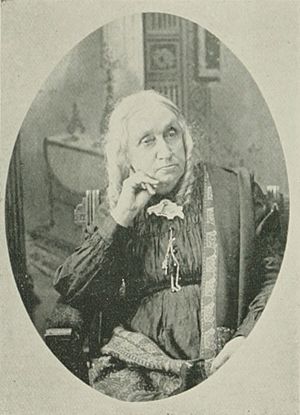Lucy N. Colman facts for kids
Lucy N. Colman (born July 26, 1817 – died January 18, 1906) was a brave campaigner for important causes. She believed in thinking freely and fought against slavery. She also worked hard for women's rights. Lucy Colman was a strong voice for racial justice and helped get better education for African Americans.
In 1891, Colman wrote a book about her life called Reminiscences. It shared her memories of the movement to end slavery.
Contents
Her Early Life and Family
Lucy Colman was born in Sturbridge, Massachusetts. Her parents were Hannah Newhall and Erastus Danforth, who was a blacksmith. Sadly, her mother died when Lucy was only seven years old.
Lucy married John Maubry Davis in 1835. He also believed in universalism, a way of thinking about religion. But John died six years later from a sickness called tuberculosis.
Eight years later, she married Luther Colman. He was killed 11 years later in a work accident. He worked for the New York Central Railroad. Lucy believed the company was at fault because they didn't spend money on repairs. The company paid for his funeral, but they refused to help Lucy financially afterward.
Lucy had one daughter named Gertrude. Having a child made Lucy think deeply about how few rights married women and mothers had. She saw that women often depended completely on their husbands for any freedom. When Gertrude died in 1862, Lucy chose a special memorial led by Frederick Douglass. It was not a traditional religious funeral.
Her First Steps for Justice
From a very young age, Lucy Colman felt upset by unfairness in the world. When she was just six, she was shocked to learn that slavery existed. She often asked her mother about it.
By the time she was 35, she had decided to leave Christianity. She did this mainly because she felt the church was involved with slavery. She didn't fully understand all the church's beliefs, but its connection to slavery bothered her deeply.
Working as a Teacher and Activist
After her second husband died, Lucy Colman became a teacher in 1854. She taught at a segregated school in Rochester, which meant only Black children could attend. Lucy was horrified by this separation. She worked hard to convince parents to take their children out of the school. This led to the school closing down.
Lucy also worked with Susan B. Anthony. They spoke together at the State Teachers' Convention. They argued against hitting children in schools (called corporal punishment). They also spoke out against unfair pay, where male teachers earned more than female teachers for the same work. During this time, Lucy became known for standing up for liberal causes. She was good at arguing with people who disagreed with her, using their own ideas against them. Within two years, Rochester began offering education to both white and Black children.
Lucy Colman even visited President Abraham Lincoln with Sojourner Truth. She helped get charges dropped against some people who were arrested. In 1880, she spoke at the same convention with Robert G. Ingersoll.
Her Work for Change
Between 1856 and 1860, Lucy Colman worked with groups like the Western Anti-Slavery Society. She also worked with the American Anti-Slavery Society. These groups fought to end slavery. In 1859, she helped gather signatures for a petition. This petition asked for women's right to vote in New York.
In 1863, she became a secretary for the Women's Loyal National League. This group organized the largest petition drive in America's history. They collected almost 400,000 signatures and gave them to Congress. This huge effort greatly helped pass the Thirteenth Amendment. This important amendment ended slavery in America.
In 1864, Lucy became a matron at the National Orphan Asylum in Washington, DC. This organization helped poor Black women and children. At the same time, she taught and supervised schools in Washington and Arlington, Virginia. She did this for the National Freedman's Relief Association. This group was created to help people who had been enslaved.
National Women's Rights Convention
This was a series of yearly meetings. Their goal was to make the early women's rights movement more visible in America. Lucy Colman went to the first meeting in Worcester in 1850.
At these meetings, people talked about many important topics. They discussed women's property rights, making marriage fairer, and creating more job and education chances for women. Lucy's friend, Amy Kirby Post, encouraged her to speak at this convention. Amy later wrote the introduction to Lucy's autobiography. Lucy spoke about the anti-slavery movement at the convention.
How She Was Remembered
In 1898, a writer named Samuel Porter Putnam described Lucy Colman. He said that even when she was old, she still had the passion of youth. He called her "radical in every direction." This meant she believed strongly in big changes. He said she was against all forms of slavery, not just Black slavery. She also worked for women's rights as well as men's rights.
Putnam noted that Lucy was a "radical Freethinker." This means she had moved past old beliefs and superstitions. She never lost interest in important issues. He said she had a busy and exciting life. She met many important people and was part of big movements. She did her part to bring about the great improvements of her time. He said she showed what a woman could do with self-reliance, energy, and a love for truth and what is right. He believed her name would shine in the history of progress.
Lucy Colman is remembered on International Women's Day and during Women's History Month. She is known as one of the most active and well-connected freethinkers of her time. People even called her "the Zelig of the Golden Age of Freethought." This means she seemed to be everywhere important during that time of free thinking.
See also
 In Spanish: Lucy N. Colman para niños
In Spanish: Lucy N. Colman para niños


